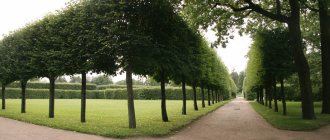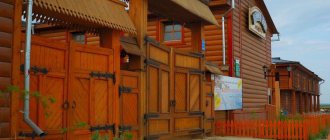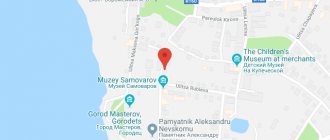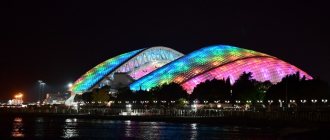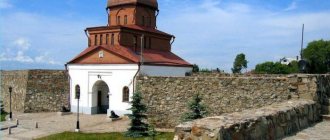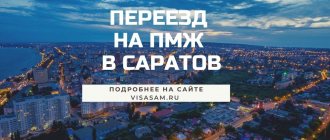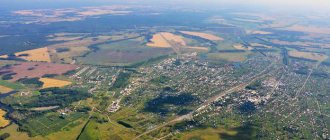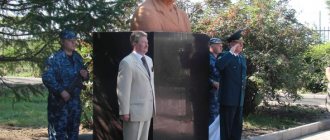RB7.ru continues its voyage through the cities of Bashkiria in search of interesting facts about the life of the province. Today we are going to the north-west of the republic - to the city of Dyurtyuli, which is located 120 kilometers from Ufa.
Quadruple house, or a little history
The history of the city dates back to 1795, when 4 Russian merchants, having decided to settle in a picturesque place on the banks of the Belaya River, built wooden houses for their families and laid out Bolshaya Street.
The peasants of the Tatar and Bashkir villages located nearby began to say among themselves “Durtөylөgә barabyz”, which translated from Bashkir means let’s go to a four-house (“dүrt” - four, “ой” - house). The constant mention of four houses turned into the name of this small village. This is how the Bashkir name was assigned to the Russian village.
City on the river bank
Dyurtyuli is a small town; its central part can be explored on foot. There is no park or special walking area, but you can walk along the long alley that stretches through the entire city.
In spring, the embankment becomes the most popular place in the city. When ice drifts on Belaya, city residents try not to miss the moment and look at this spectacle. In summer, however, it is also crowded here.
The highlight of the city can be called its springs. Improved areas delight residents not only with clean water, but also with an original solution. On one of them, for example, water is pouring from a large figure of a samovar; the people called it “Samovar”.
Sandwich made from bread, butter and sausage
If, after reading the previous article about Ishimbay, you definitely wanted to try gray Ishimbay bread, then I can say with confidence that Durtyulinsky bread is also delicious. Probably every Durtyulin resident noticed this alluring aroma of fresh baked goods coming from behind the door with the inscription “Hot Bread”. Bakery and confectionery products are baked here. The famous Dyurtyulin bagels are especially tasty.
The city is also famous for its dairy products. Kefir, sour cream, cheese and other milk products are produced here. Butter is very popular among residents; they say it has a special taste. Worth a try! After all, the products of the Dyurtyulinsky plant can also be found on Ufa shelves.
There is also a meat processing plant in Dyurtyuli. It is notable for the fact that it became the first enterprise in the republic that began producing Halal products from cattle meat.
Durtyuli
The historical development of the city of Dyurtyuli had a direct impact on both the external appearance of the city and its internal infrastructure. In the history of Durtyuli, three periods can be roughly distinguished: pre-industrial, industrial and post-industrial. The village of Dyurtyuli was first mentioned in written sources in 1795. From archival documents it is known that the first inhabitants of the village were several families of Russian settlers, among them: Nikita Avdeevich Dyakonov, Mitrofan Yakovlevich Trapeznikov, Philip Vasilyevich Chistyakovs and Vasily Petrovich. They were engaged in handicrafts, trade, and peasant labor. Initially, there were 4 houses in the settlement; residents of nearby villages called it “Durteile”.
In the “Complete list of populated places in the Ufa province for 1896,” Dyurtyuli is listed as the village of the V camp of the Birsk district near the Belaya River. The village had 132 households and 676 residents - 330 men and 346 women. In Dyurtyuli there were: a church, a zemstvo school, a bakery store, 2 steamship piers, 2 bread piers, a zemstvo hospital, 9 windmills, a brick factory, 17 trading shops, 19 grain barns, 4 bread dryers, a hop dryer, 5 bakeries ), 2 kerosene warehouses, a state-owned wine shop, a beer shop, a tea shop, markets on Mondays. The annual fair ran from September 14 to 21.
The location of the settlement in close proximity to the navigable Belaya River determined the commercial and industrial activities of the local residents. By the beginning of the 20th century, Dyurtyuli became a large merchant village; 19 mills operated here - 18 windmills and a steam flour mill, 46 trading enterprises, and a brick factory. The annual cargo turnover of the pier exceeded one million poods.
During this period, the historical center of the future city was formed, which was characterized by individual one-story and two-story brick and log houses with large private plots located over a large territory. And today in the old part of the city you can see 10 merchant houses of the early - mid-19th century, preserved in virtually their original form. At the beginning of the 20th century, much attention was paid to the development of village infrastructure in Dyurtyuli: streets were paved with stone, recreation areas and springs were improved.
After the establishment of Soviet power in the district, the electrification of Dyurtyuli began, which was completed in the 1950s, when an electrical substation was put into operation. Before this, electricity in the village was generated using a diesel generator. Up until the 80s. In the 20th century, in the old residential areas there was no centralized heating supply; houses were heated mainly with wood stoves, and water was collected from street water pumps. Since the 1980s Large-scale work began on gasification of the historical part of the city. Today, all houses here have electricity, gas, and central water and heating.
In the 1950s The industrial period began in the development of the city. It began with the industrial development of large oil fields and determined the development of infrastructure in high-rise residential areas. Thousands of young professionals came to Dyurtyuli from all over the country, and in a short time the population of the village increased several times. In 1964, the village, which by that time was a regional center, received the status of an urban-type settlement. It was necessary to build new housing for the population, industrial facilities and social facilities. For these purposes, a powerful construction base is being created, and a master plan for the development of the village is being adopted. In accordance with the plan, 86 residential apartment buildings were built before 1970, most of which were five-story. Over the next 10 years, another 56 houses were built. The new residential neighborhoods were equipped with all the necessary utilities and had centralized electrical, water and heat supplies. All the necessary social infrastructure was created in the new areas: schools, kindergartens, hospitals, shops, institutions and consumer services, children's and sports grounds.
In 1989, the village of Dyurtyuli received the status of a city of republican subordination.
In the last decade of the 20th century, urban infrastructure was actively developing in the city of Dyurtyuli, comfortable individual and multi-apartment housing was being built. Over the past 15 years, the urban area has almost doubled. A feature of the urban settlement is the rapid dynamics of the city's development, as well as the heterogeneity of urban development - here the ancient part of the city is located next to modern microdistricts, streets with one-story houses are adjacent to areas of multi-story and cottage development.
With the industrial development of the oil field, which began in the 50s of the 20th century, the city of Dyurtyuli gradually turned into an industrial center in the northwestern part of the Republic of Bashkortostan. Today, large enterprises in the oil industry are based here, enterprises in the construction industry operate, as well as those processing agricultural products. The social sphere is dynamically developing in the city - cultural, healthcare, and education facilities. An important event for the city of Dyurtyuli and for the entire region was the construction near the city of a modern road bridge across the Belaya River, which connected the Zabelsky zone with the central part of the republic.
The peculiarities of the historical location of Dyurtyuli in a picturesque natural area, surrounded by deciduous and coniferous forests, on the banks of the deep Belaya River, are a factor in the harmonization of the urban environment and have a positive effect on the level of ecological culture of the city population. A significant part of the urban settlement is occupied by green spaces; municipal authorities and the public are constantly working systematically to preserve and develop the city’s ecosystem. Dyurtyuli is considered one of the “greenest” cities of the Republic of Bashkortostan.
Field of miracles and a piece of Finland
The architecture of Dyurtyuli is very diverse. Within the city limits you can see both multi-storey residential buildings and single-storey buildings.
There is, for example, an area called “Finnish Houses”. It consists of private areas with a house and a small plot. Passing by, you can often catch the attractive aroma of a flooded bathhouse. Finns, of course, do not live here, but the name apparently comes from there (the technology for assembling frame-panel houses came to us from Finland).
Another residential microdistrict adjacent to the city is called “Field of Miracles”. Yakubovich didn’t spin the drum there, miracles didn’t seem to happen either. The name, they say, stuck due to the fact that people perceived the first such buildings as something unusual and wonderful. Now this area is more like a cottage community separate from the city.
To Venice via Moscow
If, upon hearing the word Venice, an ordinary person imagines an Italian city on the water, then a resident of Durtyulin will first of all think of a local village.
2 kilometers from the city is the local Venice - a small village on the river bank, surrounded by a pine forest. In the summer, city residents go there to relax in nature: swim in the river or camp on the shore. The road to these parts is fascinating; along the way you can enjoy beautiful views and breathe in the purest air. Venice is also famous for the fact that there is a health resort of the same name.
Getting from Dyurtyuli to Moscow is also not difficult. This is the name of the village at the entrance to the city. True, in Russian the name of the village sounds like Moscow, but in Bashkir, both the capital of Russia and the village are pronounced the same - Moscow (Bashk. Мәскәү).
Map
| Dyurtyuli: cards |
Durtyuli: photo from space (Google Maps) Durtyuli: photo from space (Microsoft Virtual Earth)
| Durtyuli. Nearest cities. Distances in km. on the map (in brackets along roads) + direction. Using the hyperlink in the distance , you can get the route (information courtesy of the AutoTransInfo website) | |||
| 1 | Verkhneyarkeyevo | 34 (61) | Z |
| 2 | Chekmagush | 40 (49) | YU |
| 3 | Birsk | 42 (67) | IN |
| 4 | Buraevo | 51 (82) | NE |
| 5 | Kushnarenkovo | 52 (49) | SE |
| 6 | Kaltasy | 53 (123) | WITH |
| 7 | Aktanysh (Republic of Tatarstan) | 55 (121) | NW |
| 8 | Krasnokholmsky | 56 (110) | WITH |
| 9 | Mishkino | 68 () | IN |
| 10 | Agidel | 74 (90) | NW |
| 11 | Bakaly | 75 (129) | SW |
| 12 | Neftekamsk | 77 (82) | NW |
| 13 | Nikolo-Beryozovka | 83 (90) | NW |
| 14 | Blagoveshchensk | 86 (128) | SE |
| 15 | Yanaul | 87 (126) | WITH |
| 16 | Amzya | 88 (106) | WITH |
| 17 | Starobaltachevo | 88 (125) | NE |
| 18 | Linguistically | 88 (172) | YU |
| 19 | Sharan | 91 (205) | SW |
| 20 | Karakulino (Udmurt Republic) | 93 (200) | NW |
| 21 | Kambarka | 96 (115) | NW |
| 22 | Mikhailovka | 99 () | SE |
| 23 | Buzdyak | 103 (119) | YU |
| 24 | Alkino-2 | 103 (126) | SE |
| 25 | Avdon | 105 () | SE |
| 26 | Chishmy | 105 (114) | YU |
| 27 | Muslyumovo (Republic of Tatarstan) | 107 (145) | Z |
| 28 | Ufa | 108 (110) | SE |
| 29 | Upper Tatyshly | 109 (165) | NE |
| 30 | Kandra | 113 (142) | SW |
| 31 | Menzelinsk | 113 (149) | Z |
a brief description of
The city is located in the Urals, on the left bank of the river. Belaya (pier), 90 km from the railway. Neftekamsk station, 126 km northwest of Ufa.
Territory (sq. km): 25
Information about the city of Dyurtyuli on the Russian Wikipedia site
Historical sketch
Known since 1795. At the end of the 19th century. large trading village. The village of Dyurtyuli developed due to the discovery of oil deposits in its vicinity. Since 1964 it has been a working village. Since 1989 the city.
The name Dyurtyuli is from the Bashkir dyurt “four”, uy “house” and -li affix.
Economy
The leading enterprise of Dyurtyuli is the oil and gas production department "Chekmagushneft".
Factories: brick, feed mills. Furniture factory. Food industry enterprises (cheese factory, brewery, meat processing plant, etc.), repairing agricultural machinery. Workshop for the production of metal-plastic pipes.
In the Dyurtyulinsky district, rye, wheat, barley, peas, buckwheat, potatoes, and vegetables are grown. They raise pigs, sheep, cattle, and horses.
Deposits of oil, limestone, sand and gravel mixtures, brick clays, peat.
Main enterprises
OIL PRODUCTION INDUSTRY
NGDU "Chekmagushneft" OJSC "Bashneft"
452300, Republic of Bashkortostan, Dyurtyulinsky district, Dyurtyuli, st.
Lenina, 9 Offers:
oil
Culture, science, education
Museum of Local Lore.
Museums, galleries, exhibition halls
Dyurtyulinsky Museum of History and Local Lore 452320, Republic of Bashkortostan, Dyurtyulinsky district, Dyurtyuli, st.
Kommunisticheskaya, 64 Phone(s): (34787) 22-787 Website: https://museumrb.ru/ Sh. Babich Museum 452315, Republic of Bashkortostan, Dyurtyulinsky district, Asyanovo village
Architecture, sights
On the eastern outskirts of the city there is a 4th century settlement. BC.
In the Dyurtyulinsky district there are natural monuments: Pribelsky pine forests, lakes Malaya Elan and Bolshaya Elan, spruce-fir forests.
| Population by year (thousands of inhabitants) | |||||||
| 1939 | 4.5 | 1998 | 30.2 | 2008 | 31.2 | 2016 | 31.0 |
| 1959 | 4.7 | 2000 | 30.6 | 2010 | 31.4 | 2017 | 30.9 |
| 1970 | 14.3 | 2001 | 30.6 | 2011 | 31.3 | 2018 | 31.0 |
| 1979 | 19.6 | 2003 | 30.0 | 2012 | 31.2 | 2019 | 30.9 |
| 1989 | 25.3 | 2005 | 30.4 | 2013 | 31.2 | 2020 | 31.0 |
| 1992 | 27.1 | 2006 | 30.7 | 2014 | 31.2 | 2021 | 31.2 |
| 1996 | 29.7 | 2007 | 31.0 | 2015 | 30.9 | ||

